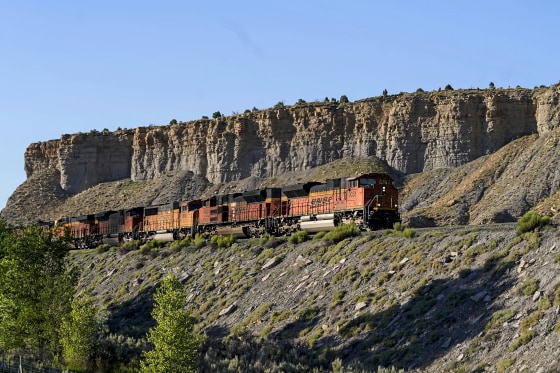WASHINGTON — The Supreme Court on Tuesday weighed the fate of an 88-mile railroad project that would transport crude oil in Utah in a dispute over whether federal officials conducted a stringent enough environmental review before approving it.
Based on the two-hour oral argument, it appeared a majority of justices were likely to conclude that the federal government's analysis was sufficient.
But the court could stop short of a broader pro-business ruling that would place new limits on the scope of such studies with the aim of speeding up the approval process for big infrastructure projects.
The railroad proposed by the Seven County Infrastructure Coalition, a group of local counties, would help bring oil from the Uinta Basin in northeastern Utah by connecting the area to the national rail network.
It is opposed by Eagle County, Colorado, which claims that it will suffer from downstream effects of the railroad, as well as environmental groups.
The federal entity overseeing the approval of the project, the Surface Transportation Board (STB), conducted an environmental review and subsequently gave it the green light to commence.
But the U.S. Court of Appeals for the District of Columbia Circuit found flaws in the analysis, as well as other parts of the approval process, and in a 2023 ruling sent it back to the agency for further review.
The focus of attention at the Supreme Court was on to what extent, if any, agencies have to consider indirect impacts that are nevertheless foreseeable. In the context of the railroad, they include the effect the project will have on oil refineries as far away as Louisiana and Texas where the cargo will eventually end up.
The appeals court said the board failed to adequately consider those broader environmental impacts as required under a federal law called the National Environmental Policy Act (NEPA).
But Supreme Court justices from across the ideological spectrum did not appear to view it the same way.
Liberal Sonia Sotomayor was among those who said that the STB's role is to focus on the environmental impact of the railroad itself, not the refineries.
"It's not the carrying [of the oil] that causes the pollution, it's the refining that causes the pollution," she added.
Likewise, fellow liberal Elena Kagan said what opponents of the project are asking for "seems to go beyond" what NEPA requires.
Conservative justices expressed similar views, with Brett Kavanaugh saying NEPA review is an area in which federal agencies should get a lot of discretion to decide what they want to include in their environmental studies.
"It seems to me the problem that has crept in is conflating what the agency can do and should do from what the role of the courts is here," he said.
Courts have taken an "overly aggressive" approach to reviewing environmental studies, which led to agencies' writing ever-longer environmental impact statements, he added.
Legislation aimed at streamlining the process that was passed by Congress last year and signed into law by President Joe Biden made it clear that NEPA review requires the agencies to weigh only “reasonably foreseeable” environmental impacts.
The law also instructs agencies to keep their written environmental reports to 150 pages, a requirement Chief Justice John Roberts said would be tough to meet unless the scope of review is somewhat limited.
"I mean, that's going to be impossible unless there is a reaffirmation that you don't have to look at things that are not within the immediate ambit of the project," he said.
There was some pushback, however, to Paul Clement, the lawyer representing the coalition, who asked the justices to adopt a legal test that would place new restrictions on what environmental impacts agencies can consider.
Conservative Justice Amy Coney Barrett, for example, told Clement she found it hard to imagine how she could write a ruling in the coalition's favor that incorporated his proposed test.
The court could rule more narrowly for the agency without adopting such a test.
The coalition appealed to the Supreme Court, saying NEPA does not require such a broad array of "imponderables" to be considered far beyond the location of the project itself.
Under the appeals court decision, the agency would have to consider the potential impact of increased crude oil refining on communities as far afield as Louisiana and Texas, the coalition's lawyers said in court papers.
The Biden administration has backed the coalition at the Supreme Court in arguing that the STB's review was sufficient.
Eagle County itself will be directly affected, with 9 out of every 10 trains that use the new railroad eventually passing through it via an existing line that runs along the Colorado River, the county's lawyers wrote in court papers.
The challengers also pointed out that even if the coalition wins on the NEPA issue, there are other elements of the STB's approval the appeals court faulted, meaning that the project would still need to undergo more review before it can move forward.
The entity constructing the railroad is a public-private partnership between the counties and two companies, infrastructure firm DHIP Group and railroad operator Rio Grande Pacific Corp.
Justice Neil Gorsuch will not participate in the case after stepping aside last week, citing the court's ethics rules. Liberal groups and more than a dozen members of Congress had urged him to recuse himself over his previous links to billionaire Philip Anschutz. One of Anschutz's companies, Anschutz Exploration Corp., which drills for oil and gas, filed a brief in the case backing the coalition.

